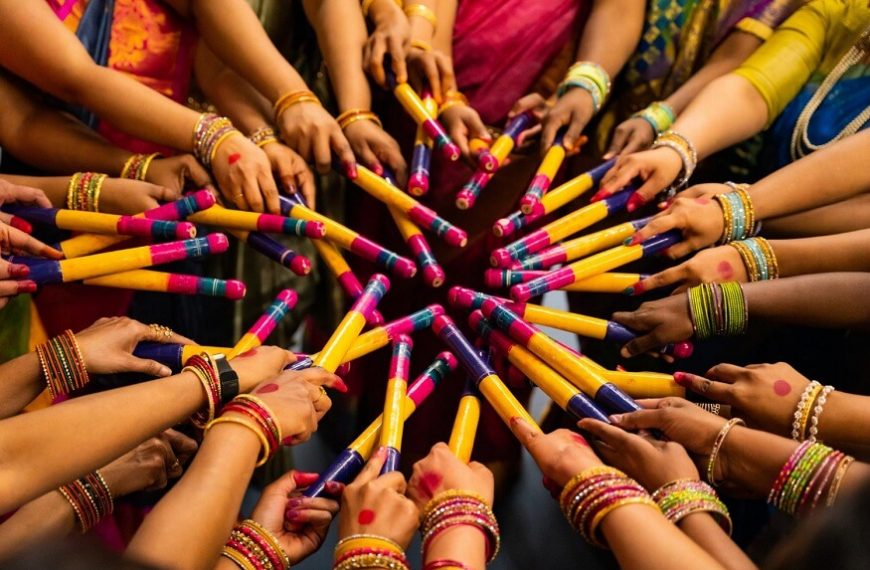The nine days of Navratri symbolise the victory of good over evil and the worship of the divine feminine energy that extends throughout the universe. Devotees gather during this festival to carry out numerous rituals, dance the exhilarating Garba, and seek the blessings of all the avatars of Goddess Durga. This year the divine feminine will be honoured for nine days beginning on October 15 and concluding on October 24 with the celebration of Vijaya Dasami.
India celebrates Navratri in a variety of ways depending on where it is observed. It honours the goddess Chamunda or Mahakali in some areas while the goddess Amba is honoured in others. The customs and traditions associated with Navratri can differ broadly, reflecting the rich cultural diversity of India.
History of the 9 Days of Navratri Festival(h2)
The “Nav” means “nine” and “Ratri” means “night.” As a result, the event got its name from the fact that we enjoyed it for nine nights. Here is a detailed explanation of all the nine forms of Goddess Durga which are worshipped during the Navratri Festival.
Day 1: Pratipada: Goddess Shailputri
The first day of Navratri is dedicated to Goddess Shailaputri, who is regarded as the symbol of the mountains. She is shown riding on a bull and is identified as the consort of Lord Shiva and the daughter of King Daksha.
Day 2: Dwitiya: Goddess Brahmacharini
Goddess Brahmacharini is worshipped on the second day. She stands for the pursuit of education and is pictured holding a water jug and a rudraksha mala (Kamandalu).
Day 3 – Tritiya: Goddess Chandraghanta
On the third day, Goddess Chandraghanta, the third form of Durga, is worshipped. She was given her name after the bell with a half-moon shape that she wore on her forehead.
Day 4 – Chaturthi: Goddess Kushmanda
The universe is thought to have been created by Goddess Kushmanda, who is honoured on the fourth day of Navratri.
Day 5 – Panchami: Skandamata
On this day, people worship Goddess Skandamata, the fifth manifestation of Durga. Her son, Lord Kartikeya, is shown resting on her lap. She is prayed by her followers for the security of their children and well-being.
Day 6 – Shashthi: Goddess Katyayani
On the sixth day, Goddess Katyayani, the sixth incarnation of Durga, is honoured. She is an image of boldness and is believed to have been born to Sage Katyayan.
Day 7 – Saptami: Goddess Kaalratri
On the seventh day, Goddess Kaalratri is the robust manifestation of drugs. Devotees pray to her for protection from negative energies.
Day 8 – Ashtami: Goddess Mahagauri
Navratri’s eighth day is devoted to the goddess Mahagauri, who is thought to have a bright, snow-white complexion.
Day 9 – Navami: Goddess Siddhidatri
Goddess Siddhidatri is honoured on the ninth and last day of Navratri. She is thought to have the ability to grant desires and assistance.
Significance of the 9 Days Of Navratri Festival
- Nine Nights of Celebration: Navratri lasts nine nights and ten days, symbolising the nine forms of Goddess Durga.
- Cultural Diversity: Navratri is observed across India with regional variations, highlighting the cultural diversity of the country.
- Seasonal Transition: Navratri signifies the change from the monsoon to the autumnal season, which is frequently connected to the harvest and agricultural rituals.
- The Victory of Good over Evil: It honours the victory of Durga over the demon Mahishasura, symbolising the victory of good over evil.
- Social Gathering: During Navratri, families and communities meet together for prayers, rituals, and joyous meals.
- Cultural Celebration: Besides its religious aspects, Navratri is a vibrant social festival, marked with music, dance, and colourful attire.
- Religious Importance: Devotees fast, pray, and perform rituals during Navratri for strength, knowledge, and protection.
Conclusion:
During the festival of Navratri, devotees joyfully adore Goddess Durga. The nine days of Navratri provide plenty of time for families to get together, relax and rejoice. In this regard, the well-known play school EuroKids is playing an essential role in maintaining and teaching these cultural traditions to the younger generation. Along with offering holistic education, EuroKids includes cultural celebrations like Navratri in its curriculum. Here children learn about the rich history and importance of Navratri in a delightful and informative manner via storytelling, arts, and crafts.
Frequently Asked Questions:
- What is the importance of the nine days of Navratri?
- What are the names of 9 Days of Navratri 2023?
- When will Navratri be celebrated in the year 2023?
- What are the Garba and Dandiya dances?
- What is the origin of the Navratri festival?
- What does Navratri convey?
- What are the nine forms of Goddess Durga which is worshipped during Navratri?
- How is Navrati celebrated in different parts of India?
Ans. Navratri is celebrated to worship goddess Durga and all her nine avatars.
Ans. Here are the nine days of Navratri: Pratipada, Dwitiya, Tritiya, Chaturthi, Panchami, Shashti, Saptami, Ashtami, and Navami.
Ans. The celebration will begin on October 15 and conclude on October 24 with Vijaya Dasami.
Ans. Dandiya Raas comprises partner dancing and sticks, whereas Garba is a traditional Gujarati dance that is performed in a circular pattern. Both are popular during Navratri.
Ans. The tenth day of Navratri, known as Vijayadashami, marks the origin of this festival showcasing the victory of Goddess Durga over the demon Mahishasura.
Ans. The world we are living in is a fast-paced one with scarcely. The nine days of Navratri are scheduled to melt down the year-long exhaustion and restore mental peace.
Ans. The nine forms of Goddess Durga worshipped in nine days are Shailputri on Pratipada; Brahmacharini on Dwitiya; Chandarghanta on Tritiya; Kushmanda on Chaturthi; Skand Mata on Panchami; Katyayani on Shashthi; Kaalratri on Saptami; Mahagauri on Ashtami and Siddhidatri on Navami.
Ans. Navratri is celebrated in different ways throughout India. It is a time of religious introspection and fasting while it is also a time for dance and feasting.














